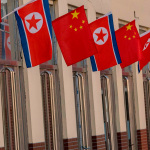Relations of Russia and China with Central Asia have a rich history in which politics, economics and security are closely intertwined. Traditionally, the Central Asian direction has been one of the key areas in the foreign policy of Russia and China. This seems obvious, given the location of the region in the center of Eurasia – at the intersection of geographical, political, economic and security interests of the two countries. At the same time, another significant feature is that, looking from the economic point of view, Central Asia has never been an object of a large-scale Russian-Chinese rivalry. This is largely due to the fact that the periods of the economic activity of Russia and China in the region can be accounted for various historical periods.
During the heyday of the Great Silk Road, government entities located on the territories of modern Central Asia served as a transport bridge between China and Europe. Back to the times, China was the main external actor of the region’s economic development, a source of scientific knowledge and advanced technologies. The development of maritime transportation in the era of the Great Geographical Discoveries in the Sixteenth century AD caused a reorientation of world trade from land routes, that were predominantly based on the Great Silk Road to the sea ones. The significant cheapness of maritime transport has led to a relative economic and geographical isolation of Central Asia.
In the second half of the XIX century, when Central Asia became a part of the Russian Empire, the political, economic and cultural ties of the region began to focus more on Russia. This contributed to the end of Central Asian economic and geographical isolation and a significant intensification of economic ties. With the fall of the Russian Empire, a fundamentally new stage in Russian-Central Asian relations began. During the times of the USSR, economic growth was unprecedented in the history of both Russia and the Central Asian states. It was a period of the formation of the main statehood features in the countries of the region. Until the collapse of the Soviet Union, it was Russia that was the main actor in the social, economic, scientific and technological development of Central Asia, having a decisive influence on the formation of the of the region we can see nowadays.
The collapse of the USSR in 1991 led to the collapse of Russia’s economic ties with the independent Central Asian republics that included Kazakhstan, Kyrgyzstan, Tajikistan, Turkmenistan and Uzbekistan. This has given an incentive to the region’s development and further intensification of economic relations between the five states and China. Moreover, during the 1990s, Russia did not pay much attention to the development of its relations with Central Asia, while China and many other countries began to gradually increase their influence [4].
Nowadays, Russia has realized the importance of the post-Soviet space while implementing the ideas of strengthening its positions on the international arena, therefore, we can observe the acceleration of the process of political rapprochement with the Central Asian states. This, in turn, has also contributed greatly to a significant intensification of economic and security cooperation. What can be the result of the simultaneous rapid increase in the presence of Russia and China in Central Asia and their current regional projects that are being observed today, perhaps, for the first time in history? This essay will attempt to answer this question through a detailed analysis of the actions of Moscow and Beijing in the region in the sphere of politics, economy and security and define some current issues in the field focusing primarily on the modern stage.
Economic development. Eurasian Economic Union VS One Belt, One Road?
Russia maintains and strives to develop a number of joint integration institutions that could possibly serve as platforms for interaction with the states of the region. Among them, we can outline the Commonwealth of Independent States, the Eurasian Economic Union (formerly the Customs Union) and the Collective Security Treaty Organization. At the same time, by virtue of the not yet completely wasted Soviet legacy and certain efforts, caused, among other things, by the deepening crisis in relations with the West, the Russian Federation stand up for the right to be the main external partner for the Central Asian countries.
In turn, relations between China and the region, although rooted much deeper in the past, and in the last two decades have been developing more dynamically than Russian-Central Asian relations, have, however, their own specifics. They can be characterized by deep mutual fears and prejudices. In many respects, this is precisely why the actions of China in Central Asia are quite cautious, which can be observed to the greatest extent in the fields of politics and security. China, however, is showing greater activity in the economic sphere and has been constantly increasing its presence over the past 2 decades [2]. This is especially noticeable in the framework of the One Belt, One Road initiative and related economic and other projects. The main role here belongs to transport and infrastructure projects and plans for their implementation. The most important of these projects is the China-Kyrgyzstan-Uzbekistan railway construction project, although slowly but persistently promoted by all three countries. On the other hand, Russia still does not have any perspective projects of such a big scale. Given this kind of economic activity, supported by Beijing’s significant political and diplomatic efforts, one must agree that in recent years the PRC has dramatically strengthened its position in Central Asia. The PRC is interesting to the region as a country with almost unlimited financial capabilities, and the country that also wants to develop the infrastructure of transport links, ports, logistics, and create production facilities with modern technologies.
At the same time, Beijing is still trying to coordinate its policy in the region with Moscow, recognizing its unique historical role in Central Asia. This fact can in many respects explain many Chinese successes and achievements in the region. We can observe that Russia in some degree continues to support or at least not actively restrain the processes of the PRC consolidation in Central Asia. First of all, this applies to those areas where Chinese interests do not contradict with the Russian ones, and in some cases even supplement them. For example, in the fields of politics and security, in the context of countering the development and migration of radical Islamism in the region, and limiting the influence of other foreign actors, particularly, NATO and the USA.
The emergence of similar regional projects for Central Asia: the Eurasian Economic Union or the vision of “Greater Eurasia” initiated by the Russian Federation and the One Belt, One Road initiated by China, has probably become the most significant problem for Russia – China bilateral cooperation in the past 2 decades. The EEU is so far the Russia’s largest political and economic project for Eurasia. It is worth mentioning that first it was not focused on Central Asia, but started to do so after the evolving crises in Ukraine and impossibility of its membership. By that time, the Chinese factor was already relatively important as the Chinese government had proposed the way of future cooperation within the One Belt, One Road initiative [5].
Chinese and Western observers viewed Russia’s plans to strengthen regional integration as a way to halt China’s economic growth, Russians considered the projects of the One Belt One Road in the region as a response to the ones of the Eurasian Economic Union. Therefore, some expectations of Russia and China clashing in the region became quite popular. The governments of both countries very quickly understood the possible negative consequences of such clash and took several steps to reduce the likelihood of rivalry, including a 2014 joint communiqué, 2015 memorandum aimed at matching initiatives of the both, and 2018 China – EEU trade agreement with the EAEU, which reduced some non-tariff barriers and simplified customs procedures [6].
The leaders of Russia and China have repeatedly stated the possibility of the coexistence and cooperation of EEU and BRI, but this is not an easily achievable plan. The Chinese project is much larger than the Russian one and have all the chances to make its competitor even more insignificant. In the long run, this will necessarily lead to a complete reorientation of the Central Asian economies to China.
SCO vs CSTO?
In the 1990s, economic and security cooperation between China and Central Asian states that had recently acquired their independence saw an unprecedented growth. This was not only an attempt to stabilize the region internally, but also to better control migration flaws in the near-abroad and cross-border separatist movements [3]. Such cross-border movement became problematic or sometimes even impossible. Much credit for this can be given to the Shanghai Five Organisation (later became the Shanghai Cooperation Organisation), which was created with the intentions of guaranteeing security in Central Asia, increasing China’s influence and preventing the Republics from providing more assistance to Uyghur activism and migration, which has been a long-existing problem for the PRC. In this field, both Russia and China face identical threat of evolving terrorist movements that could potentially destabilize such regions as North Caucasus and Xinjiang. It is also clear that the interaction between the PRC and Russia is significantly facilitated by the existence of such common institution as the Shanghai Cooperation Organization (SCO) with four out of five Central Asian countries (Kazakhstan, Kyrgyzstan, Tajikistan and Uzbekistan). And although Turkmenistan is not formally a member of the SCO, it is de facto also involved in the processes of interaction with the member countries of this Organization. The SCO has become a useful platform for cooperation in the field of security, allowing both states to conduct joint military exercises and create a platform for “sharing advanced authoritarian experience” in the field of internal security. However, most of the cooperation within the SCO can be seen as declarative and limited to adoption of different agreements in the field of combating terrorism [7]. Despite the fact that after the recent expansion and inclusion of India and Pakistan, the SCO has been struggling with its further development, Russia, China, and the Central Asian countries have managed to maintain trusting relations within the Organization.
Allison stresses that the Collective Security Treaty Organization in turn can be considered as a group of states that have bilateral relationships with Russia but not really between each other, resolving different political or military problems in direct cooperation. Some leaders also admit that most of the time cooperation can be done without any coordination within the CSTO [1]. Such ineffective collaboration and governance create a lot of obstacles to the efficiency and functioning of the CSTO, where Moscow instead of strengthening strategic ties and functional cooperation asks for implicit loyalty from the other participating countries [5].
There is a profound difference in how Russia and China view the development of the Shanghai Cooperation Organisation in areas other from the security, which greatly affects the utility of the organization and Russia-China relations in a negative way. Beijing considers the SCO as a primarily regional organization which aims at protecting the interests of the PRC in Central Asia and in Xinjiang. For China the SCO is an Asian analogue of NATO with the perspectives of further cooperation in the fields of economics, energy and trade, there have even been some attempts to create a development bank within the organization, but the initiative faced an objection from Russia. Energy sector is also particularly important for the Chinese side as the country has been constantly making steps to diversify its supplies as Central Asia can be considered more reliable than some Middle Eastern countries [7]. Moreover, the government does not support the idea of close cooperation between SCO and CSTO being afraid that it might significantly increase and strengthen the Russian role, when other participating countries seem to have no objections. Moscow, on the other hand, tends to consider the SCO as a geopolitical union with anti-Western focus, especially, after the 2014 confrontation with the Western countries [6]. Considering this kind of rhetoric, some may see a possibility of competition over hegemony in the region and high tensions because of the existing hierarchy. So far it seems like the further decrease in cooperation between the CSTO and the SCO is very likely to continue in the future as Russia is not willing to give up its bilateral assertions and China is becoming more and more confident in influencing the region in its own.
Conclusion
Up to now, there are several trends that can show us a lack of competition or at least rivalry between the two countries in Central Asia. They include, but not limited to, the efforts of both to prevent any escalation that result in some degree of moderation and different views on how regional organizations should look like. Practically, due to increasing interdependence and contrasting interests both sides simply do not pay much attention to any issues that exist or are about to evolve between them in the near future. They build their policies in the region on a different basis: Beijing creates a foothold and claims to gain influence in this resource-rich and strategically important region, and Russia has been trying to maintain the influence and connection it has since the times of USSR.
In order to be able to call the cooperation of both states in the region “complimentary”, there is a clear need for them to form a common view on the organizations that currently exist in Central Asia and develop more trust in multilateral partnerships. The likelihood that the formula for the future progress and prosperity in Central Asia will consist of the restoration of the Great Silk Road and the development of the Shanghai Cooperation Organization, the only structure that unites Russia, China and Central Asian countries, is very high. This is due to greater economic and political capabilities of Beijing. Therefore, in addition to supporting China’s initiatives and strengthening the SCO, this sustainable channels of dialogue and interaction with the integration structures of the post-Soviet space are required. A large-scale coordination of the efforts of China and Russia in Central Asia might be a great asset for the region’s development.
- Allison R. (2018). Protective Integration and Security Policy Coordination: Comparing the SCO and CSTO, The Chinese Journal of International Politics, Volume 11, Issue 3, 297–338, https://doi-org.libproxy.ucl.ac.uk/10.1093/cjip/poy008
- Chen Y.& Günther O. (2018). Back to Normalization or Conflict with China in Greater Central Asia?, Problems of Post-Communism, DOI: 10.1080/10758216.2018.1474716
- Clarke M. (2008). China’s “War on Terror” in Xinjiang: Human Security and the Causes of Violent Uighur Separatism, Terrorism and Political Violence, 20:2, 271-301. URL: https://doi.org/10.1080/09546550801920865
- Czarkowska E. (2014). Russia and China in Central Asia: Evolving Strategies. International Affairs. Retrieved from https://dlib.eastview.com/browse/doc/43148291
- Heathershaw J., Owen C. & Cooley A. (2019). Centred discourse, decentred practice: the relational production of Russian and Chinese ‘rising’ power in Central Asia, Third World Quarterly, 40:8, 1440-1458, DOI: 10.1080/01436597.2019.1627867
- Kaczmarski M. (2019). Russia-China Relations in Central Asia: Why Is There a Surprising Absence of Rivalry?, The Asian Forum, University of Glasgow. URL: http://www.theasanforum.org/russia-china-relations-in-central-asia-why-is-there-a-surprising-absence-of-rivalry/
- Somzhurek, ZH. B., et al (2018). Central Asia and regional security, Communist and Post-Communist Studies 51, pp.161-171





